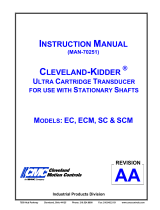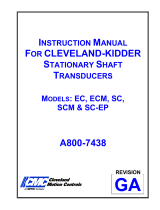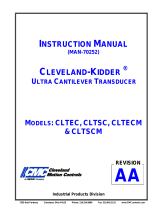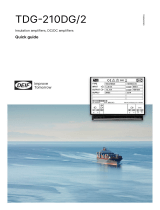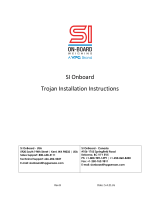Page is loading ...

INSTRUCTION MANUAL
(MAN-70436-0)
FOR
ULTRA ISC UNDER PILLOW BLOCK
TRANSDUCER
MODELS: UPB1 & UPB2
AA
REVISION
Cleveland Motion Controls

ULTRA ISC SERIES UNDER PILLOW BLOCK TRANSDUCER MAN-70436-0 REV AA
REVISION HISTORY
Rev ECO# Author Date Description of Change
AA -- WGW As Released
II

MAN-70436-0 REV AA ULTRA ISC SERIES UNDER PILLOW BLOCK TRANSDUCER
WARRANTY AND LIMITATION OF LIABILITY
All equipment is sold subject to the mutual agreement that it is warranted by the company to be free
from defects of material and workmanship but the company shall not be liable for special, indirect or
consequential damages of any kind under this contract or otherwise. The company’s liability shall be
limited exclusively to replacing or repairing without charge, at its factory or elsewhere at its discretion,
any material or workmanship defects which become apparent within one year from the date on which
the equipment was shipped, and the company shall have no liability for damages of any kind arising
from the installation and/or use of the apparatus by anyone. The buyer by the acceptance of the
equipment will assume all liability for any damages which may result from its use or misuse by the
buyer, his or its employees, or by others.
The warranties of the company do not cover, and the company makes no warranty with respect to any
defect, failure, deficiency, or error, which is:
Not reported to the company within the applicable warranty period, or
Due to misapplication, modification, disassembly, abuse, improper installation by others, abnormal
conditions of temperature, dirt, or corrosive matter, or
Due to operation, either intentional or otherwise, above rated capacities or in an otherwise improper
manner.
There are no other warranties, expressed or implied including the implied warranties of merchantability
and fitness for a particular purpose.
III

ULTRA ISC SERIES UNDER PILLOW BLOCK TRANSDUCER MAN-70436-0 REV AA
IV
BLANK

MAN-70436-0 REV AA ULTRA ISC SERIES UNDER PILLOW BLOCK TRANSDUCER
TABLE OF CONTENTS
REVISION HISTORY..........................................................................................................................II
1 PRODUCT OVERVIEW....................................................................................................................1
1.1 GENERAL DESCRIPTION......................................................................................................................................1
1.2 FEATURES..........................................................................................................................................................2
1.3 HOW IS THE ULTRA ISC USED.............................................................................................................................2
1.4 CE EMC RESPONSIBILITY...................................................................................................................................2
1.5 GENERAL SPECIFICATIONS..................................................................................................................................3
1.6 PHYSICAL SPECIFICATIONS .................................................................................................................................3
1.7 ENVIRONMENTAL REQUIREMENTS .......................................................................................................................3
1.8 OPERATING CONDITIONS.....................................................................................................................................4
1.9 EMC TECHNICAL RATINGS .................................................................................................................................4
1.10 EMISSION SPECIFICATIONS ................................................................................................................................4
1.11 SPECIFICATIONS ...............................................................................................................................................4
1.12 BLOCK DIAGRAM OF ULTRA SERIES ISC AMPLIFIER MODULE ............................................................................5
2 PRODUCT COMPONENTS...............................................................................................................6
2.1 M12 MATING CONNECTOR..................................................................................................................................7
2.2 ELECTRICAL CONNECTIONS AND WIRING.............................................................................................................8
2.3 CABLING ............................................................................................................................................................8
2.4 POWER SUPPLY REQUIREMENTS.........................................................................................................................9
2.4.1 Interface wiring......................................................................................................................................................10
2.5 POTENTIOMETERS ADJUSTMENTS (IF NEEDED)..................................................................................................10
2.5.1 Correct Adjustment Tools......................................................................................................................................10
3 PRODUCT APPLICATION..............................................................................................................11
3.1 FINAL CALIBRATION ..........................................................................................................................................11
3.2 SUMMING .........................................................................................................................................................12
4 INSTALLATION............................................................................................................................14
4.1 RECEIVING AND UNPACKING .............................................................................................................................14
4.2 BEFORE INSTALLING THE TRANSDUCER.............................................................................................................14
4.2.1 Safety Considerations ...........................................................................................................................................14
4.2.2 Mounting Configurations........................................................................................................................................15
4.2.3 Mounting Hardware and Fastener Torque Recommendations..............................................................................16
4.2.4 Mounting Dimensions............................................................................................................................................17
4.3 PRE-INSTALLATION PRECAUTIONS ....................................................................................................................18
4.3.1 Roll Balance..........................................................................................................................................................18
4.3.2 Critical Roll Speed.................................................................................................................................................18
4.3.3 Avoiding Damage to the Roll.................................................................................................................................18
4.4 INSTALLING THE UNDER PILLOW BLOCK TRANSDUCER ......................................................................................19
4.4.1 Orienting The Under Pillow Block Transducer.......................................................................................................19
4.4.2 Mounting Surface Preparation...............................................................................................................................19
4.4.3 Mounting the Transducer to the Machine Frame...................................................................................................19
4.4.4 Mounting the Pillow Block Bearing to the Load Cell ..............................................................................................20
4.4.5 Extremely Severe Applications..............................................................................................................................20
4.4.6 Shaft Expansion ....................................................................................................................................................21
4.4.7 Mounting the Sensing Roll.....................................................................................................................................21
4.4.8 Checking The Transducer Mounting......................................................................................................................21
V

ULTRA ISC SERIES UNDER PILLOW BLOCK TRANSDUCER MAN-70436-0 REV AA
4.5 POWER-UP AND TESTING ..................................................................................................................................22
4.5.1 Before Applying Power..........................................................................................................................................22
4.5.2 Power Application..................................................................................................................................................22
4.6 ADJUSTMENT TOOLS (ONLY IF NOT USING NUMERICAL CORRECTION) ...............................................................23
4.7 GAIN AND FINE ZERO CALIBRATION ..................................................................................................................23
4.8 PROPER PRACTICES FOR APPLYING CALIBRATION FORCES ...............................................................................24
4.9 APPLYING FORCE TO TRANSDUCERS.................................................................................................................25
4.10 CALIBRATION ACCURACY CONSIDERATIONS....................................................................................................25
4.11 FINAL CALIBRATION........................................................................................................................................26
4.12 EMC CONNECTIONS AND INSTALLATION..........................................................................................................27
5 TROUBLE SHOOTING ..................................................................................................................29
6 MANUFACTURERS DECLARATION OF CONFORMITY .......................................................................31
VI

MAN-70436-0 REV AA ULTRA ISC SERIES UNDER PILLOW BLOCK TRANSDUCER
WARRANTY
Cleveland Motion Controls warrants the goods against defects in design, materials and workmanship for the period of 12
months from the date of delivery on the terms detailed in the Cleveland Motion Controls, Inc. Terms and Conditions of Sale,
document number AO-90131
Cleveland Motion Controls, Inc. reserves the right to change the content and product specification without notice.
© 2009 in this document is reserved to:
Cleveland Motion Controls, Inc.
7550 Hub Parkway
Cleveland, OH 44125
216-524-8800 Phone
216-642-2199 Fax
INTENDED USERS
This Instruction Manual is to be made available to all persons who are required to configure, install or service the tension
transducer equipment described in this manual or any other related activity.
ADDITIONAL INFORMATION
For the latest product information, technical literature etc., visit our website at www.cmccontrols.com
ATTENTION: The following information is provided merely as a guide for proper installation. Cleveland Motion Controls
cannot assume responsibility for the compliance (or failure to comply) to any code (national, local or other) that prescribes the
proper installation of this electro-mechanical device or associated equipment. A hazard of personal injury and/or property
damage can exist if applicable codes are not adhered to.
CONTACT INFORMATION AND SERVICE ASSISTANCE
For service assistance, have the following information available:
Type of Transducer you are using
Maximum working force
Purchase order number
To contact us, visit our website at www.cmccontrols.com or use the following numbers:
Phone: 216.524.8800
Fax: 216.642.5159
Disassembly by improperly trained personnel may result in additional damage to these units. Should repairs
be required or for warranty repairs, contact the Customer Service Department for a return authorization
number before returning the units.
VII


MAN-70436-0 REV AA ULTRA ISC SERIES UNDER PILLOW BLOCK TRANSDUCER
1 PRODUCT OVERVIEW
1.1 GENERAL DESCRIPTION
The Ultra Series Integrated Signal Conditioning (ISC) Under Pillow Block (UPB) transducer (see Figure 1)
outputs a +/- 10 VDC signal for reporting signals from strain gage-based load cells. Ultra ISC transducers
include an Integrated Signal Conditioner (ISC) amplifier that is coupled directly to the “Ultra” type load cell
employing semiconductor strain gages. This local processing reduces the signal degradation due to long
wires to the driving displays or recording devices.
Because the output stage is free to float, be aware of voltage differences on the output
side of the tension transducer with respect to protective earth ground.
Figure 1 Ultra Series Integrated Signal Conditioning (ISC) Under Pillow Block Tension Transducer
The Integrated Signal Conditioning (ISC) amplifier has a separate ground reference (common) for the output
signals. The ground used by the output circuits is electrically separate from the ground return for the fixed
24Vdc supply. The 24Vdc supply input is protected against reverse polarity.
The Integrated Signal Conditioning (ISC) tension transducer uses an embedded Instrumentation Amplifier (IA)
to amplify the millivolt level signals generated by the strain gage bridge, while effectively rejecting common-
mode noise. Low drift Surface Mount Technology (SMT) components, Multi-layer Printed Circuit Boards
(PCB) and optimum circuit topologies are incorporated to promote load cell signal integrity.
The Amplifier gain is adjustable over a 9.6:1 range to allow span calibration of the analog outputs.
A precision low voltage excitation source is provided for exciting the strain gage elements in the internal strain
gage bridge.
The use of galvanic isolation can aid in reducing noise pickup caused by ground loops in the field wiring and
accommodates limited voltage gradients between input and output sections of the application wiring.
Performance Benefits
The Ultra ISC Line UPB (Under-Pillow-Block) Washdown-Duty LC (load cell) has a completely sealed
corrosion-resisting design, making it ideal for use in demanding industrial environments, including the
production of paper, steel, textiles, roofing shingles, linoleum, rubber, foil, and food products.
The Ultra ISC Line UPB Washdown-Duty LC is made from a solid block that results in a completely sealed
design with a very low profile. It is typically applied in pairs, one under each of the supporting guide roll’s
pillow block bearings.
1

ULTRA ISC SERIES UNDER PILLOW BLOCK TRANSDUCER MAN-70436-0 REV AA
To assure maximum corrosion and chemical resistance, the Ultra ISC Line UPB Washdown-Duty LC is made
from either Stainless Steel or Aluminum Alloy depending on the size rating. Displacement from loads is
negligible (typically 0.002 in.) and the output is temperature compensated.
1.2 FEATURES
Ultra ISC load cell features are:
Factory Calibration promotes interchangeability
Tension controller observation of individual loadcell signals provides increased opportunity for
advanced diagnostics and calibration.
Self contained precision excitation circuit eliminates the need for the expense and complication of
remote sense
24V supply has reverse polarity protection
Analog output buffer designed to accommodate capacitive cable loads.
Floating strain-gage and output stage allows “stacking” ISC outputs for simple summing.
Sealed enclosure and M12 connector provide environmental protection
Industry standard M12 allows use of readily available molded cordsets
1.3 HOW IS THE ULTRA ISC USED
The Ultra ISC load cell has been developed for those customers who desire to send the amplified transducer
signal directly into their Controller, PLC, PAC, Drive, or Local I/O.
The signal outputs are zeroed, scaled, and summed (if a pair of transducers is used) by software. It is
the responsibility of the customer to write this software.
The Ultra ISC load cell is shipped preset from CMC with 0 volts representing no load, and 10 volts
representing the 100% full rating of the transducer. (Example: A 100 lb Ultra ISC transducer with no load
outputs 0 volts. With a 100 lb. load the output is 10 VDC when loaded in one direction and -10VDC when
loaded in the opposite direction.)
1.4 CE EMC RESPONSIBILITY
The Integrated Signal Conditioning (ISC) Amplifier Ultra ISC Series module embedded in the load cell can
be considered a component performing a direct function and therefore is subject to the provisions of the EMC
Directive.
To assist manufacturers, suppliers, and installers of relevant apparatus, this amplifier module is compliant to
EN61326:1997 when installed according to these instructions. Manufacturers, suppliers, and installers of
relevant apparatus may use this compliance as a contributing basis for their own justification of overall
compliance with the EMC Directive.
Before installing the Ultra Series ISC Amplifier you must clearly understand who is legally responsible for
conformance with the EMC Directive. Misappropriation of the CE mark is a criminal offense.
2

MAN-70436-0 REV AA ULTRA ISC SERIES UNDER PILLOW BLOCK TRANSDUCER
1.5 GENERAL SPECIFICATIONS
Item Specification Comments
Input Supply
Power Supply Requirements 21.6-26.4 VDC @ 50mA Basic Isolated Amplifier
Load Cell (Transducer)
Transducer Excitation (Vexc) 3.0 VDC FIXED Internally supplied.
Amplifier
Calibration Range Min. 0.9 - Max. 9 Multi-turn Gain adjustment provided.
Zero Adjustment Output Zero Preset at CMC – Accessible
by user if absolutely necessary 0V=Zero force on beam
Span (Gain) Adjustment Preset at CMC – Accessible by user if
absolutely necessary Adjustments provided
Amplifier Output Signal +/-10 VDC @ 2 mA
+/-10 is undamped signal
Isolation
Isolation +/- 50 V max. output circuit potential not to exceed
50 V from protective earth potential
1.6 PHYSICAL SPECIFICATIONS
Item Specification Comments
Enclosure Type
Integrated Signal Conditioning mountable
with special adjustments accessible from
the surface. Remove sticker or screw to
access the setup potentiometers.
Aluminum enclosure just behind the
M12 connector.
Enclosure Size Base: 26 mm wide by 26 mm high
Length 43 mm 1.0 inches (width) by 1.0 inches
(height) 1.7 inches (depth)
Weight – Basic Amplifier 50 Grams 2.5 ounces
Connector 4 Pin M12 Quick-connect M12 Quick-connect 4 Pin, DC Keyed
1.7 ENVIRONMENTAL REQUIREMENTS
Requirement Description
Enclosure IP65
Operating temperature 0 to 70 degrees C
32 to 158 degrees F
Humidity Non-condensing
85% at 55 degrees C
85% at 132 degrees F
Altitude 1000 meters
3300 feet
Atmosphere Non-flammable, non-corrosive and dust free
Storage temperature range -30 to 90 degrees C
-22 to 194 degrees F
Transport temperature range -40 to 80 degrees C
-40 to 176 degrees F
3

ULTRA ISC SERIES UNDER PILLOW BLOCK TRANSDUCER MAN-70436-0 REV AA
1.8 OPERATING CONDITIONS
Condition Isolated Signal Conditioning Amplifier
Installation category Category III
Pollution Pollution Degree 2
Input supply Earth (Ground) referenced
Protection Enclosure mounted
1.9 EMC TECHNICAL RATINGS
Port Phenomenon Test Standard Level Test Standard
Enclosure ESD EN 61000-4-2: 8KV AD, 1KV CD EN 61326:1997
Enclosure RF Field EN 61000-4-3 10V/m,1 Khz AM EN 61326:1997
DC Supply Leads Fast Transient
Burst EN 61000-4-4 1kV EN 61326:1997
Output Leads Fast Transient
Burst EN 61000-4-4 1kV EN 61326:1997
DC Supply Leads Conducted
Immunity EN 61000-4-6 3V/m EN 61326:1997
Output Leads Conducted
Immunity EN 61000-4-6 3V/m EN 61326:1997
1.10 EMISSION SPECIFICATIONS
Port Phenomenon Test Standard Level Generic Standard
Enclosure Radiated EN 61326:
1997 Class A EN 61326:1997
The levels of performance indicated are achieved when the Isolated Signal Conditioning Amplifier is
installed by using the instructions and specifications outlined in this document.
1.11 SPECIFICATIONS
Item: Specification:
Transducer Weight UPB1 UPB2
1.5 lbs.
0.68 kg. 12 lb.
5.4 kg
Mounting Plate with screws UPB1 UPB2
2.2 lbs.
1 kg. 10 lb.
5 kg
Material
Strain Sensing beam – UPB1: 6061Aluminum
UPB2: 410 Stainless steel
Mounting Plate – 304 Stainless steel
Finish Material UPB1 only: Anodized Aluminum
Mounting Surface Flatness 0.002 inches from one side of transducer to the other.
Bridge Resistance Steel Transducer: 135-147 Ohms @ 20 o C
Aluminum Transducer: 122-134 Ohms @ 20 o C
Gage Type Semi-conductor strain gage, gage factor equals 95 (nominal)
Excitation Voltage 3.0 VDC Fixed
(Excess voltage can cause permanent damage)
4

MAN-70436-0 REV AA ULTRA ISC SERIES UNDER PILLOW BLOCK TRANSDUCER
Nominal Output Signal at Rated
MWF +/- 120 mV per Transducer (with 3.0 VDC Fixed excitation voltage)
Output Impedance Steel Transducer: Approximately 64 Ohms per Bridge leg
Aluminum Transducer: Approximately 60 Ohms per Bridge leg
Ultimate Overload 500% MWF (typ) for units rated 10,000 M.W.F or less
250% MWF (typ) for units rated at 20,000 M.W.F or more
Maximum Voltage, Gage to
Beam or Base (Ground) 50 Volts peak
1.12 BLOCK DIAGRAM OF ULTRA SERIES ISC AMPLIFIER MODULE
Figure 2 Block Diagram of Ultra Series ISC Amplifier Module
5

ULTRA ISC SERIES UNDER PILLOW BLOCK TRANSDUCER MAN-70436-0 REV AA
2 PRODUCT COMPONENTS
The Ultra Series ISC Under Pillow Block (UPB) Transducer (see Figure 3) consists of a housing that
contains the amplifier and power supply boards that are coupled directly to an “Ultra” type load cell. There is
an M12 connector to send amplified transducer signals into a tension controller, PLC, PAC, drive or local
I/O. This housing has two access holes for gain and zero potentiometer adjustments if necessary.
Figure 3 Ultra Series ISC Under Pillow Block (UPB) Tension Transducer
6

MAN-70436-0 REV AA ULTRA ISC SERIES UNDER PILLOW BLOCK TRANSDUCER
2.1 M12 MATING CONNECTOR
The M12 connector used on the Ultra Series ISC amplifier is a four-pin, DC keyed, male connector that
mates directly with the molded cordset offered by Cleveland Motion Controls. Table A lists the pin
numbers, signal, function, wire colors and any notes that apply:
When mating the connector, align
the keying mechanism and pins so
that they enter the socket without
you having to apply excessive
force. Use your fingers to
sufficiently tighten the coupling
nut enough to ensure an adequate
seal and to discourage accidental
loosening.
Figure 4 Front View of M12 Connector
Pin # Signal Function Wire
Color Notes
1 24 VDC Power Supply source
24 Vdc Brown +24 VDC
@ 50 mA max
2 +/- 10V OUT Voltage Signal Output
Undamped bi-polar
tension signal White max. load 2 mA
3 0V RET Power Supply Return Blue Must not exceed 25 volts from P.E.
4 COMMON Signal Output Return Black Common for +/- 10V a analog output
Must not exceed 25 volts from P.E
Table A M12 Connector Pin # Signals
If you choose to make your own cables or need to repair damaged connectors, you can purchase a separate mating
connector from Cleveland Motion Controls. To order, use CMC part number, X43-34338.
A fuse with a rating of 0.25A must be used in the fixed 24 VDC supply lead to limit potential damage to the
amplifier in the event of circuit malfunction. Bussman GMA-250-R
Transducers (load cells) use strain gages which have limited insulation levels to ground (earth). This
requires that the COM terminals be referenced to ground (earth) to prevent damage to the transducers
(load cells).
7

ULTRA ISC SERIES UNDER PILLOW BLOCK TRANSDUCER MAN-70436-0 REV AA
2.2 ELECTRICAL CONNECTIONS AND WIRING
Refer to Figure 5 Installation Wiring Diagram for making the transducer to power supply and tension
controller connections. Make certain that:
The cables do not interfere with the web path, and that they are away from power transmission
gearing or other moving parts.
You exercise care when routing the cables to avoid pick-up from noise-radiating power cabling
(motor armature leads, AC main wiring, etc).
In environments with severe electromagnetic noise, it may be necessary to route the cables inside
metallic conduit.
Polarity changes are accommodated by reversing the physical orientation of the transducer, by
interchanging the black and white output wires or by changing the settings in the user’s application
software.
Figure 5 Installation Wiring Diagram
2.3 CABLING
Important: Most start-up problems are the result of mis-wiring or failure to reference the detailed
information in this manual.
The connector for the ISC is a standard 4-pin M12 quick-connect connector keyed for DC operation. Molded
cordsets are readily available (see Table B) that can provide a direct connection between the ISC equipped
Tension Transducer, the required 24 VDC supply and tension controller (PLC, Tension Indicator, Analog
Input Module, etc). Ready-made PUR (polyurethane) jacketed cordsets are available in different lengths and
different connector orientation (straight or right-angle) from Cleveland-Motion Controls. It is advisable to
employ an overall outer shield (or place cable in a metallic conduit) for noise rejection in environments
with high levels of electromagnetic interference.
The wire gage should be a minimum of 24 AWG to aid in minimizing undesirable voltage drops. An overall
outer shield is required, with the shield connected to ground at the tension controller through as short a
connection as possible. The short connection is essential in minimizing parasitic inductance and thereby
maximizing the shielding effectiveness at high frequencies.
8

MAN-70436-0 REV AA ULTRA ISC SERIES UNDER PILLOW BLOCK TRANSDUCER
Exercise care in routing the cable to minimize electromagnetic interference from noise generating wiring and
equipment.
Table B lists the part numbers and descriptions for these available cordsets (Get from Web marketing):
Length Cordset Part
Number Connector
Orientation Cordset Part
Number Connector
Orientation
3M X44-33975-010 Straight X44-33976-010 Right-Angle
8M X44-33975-026 Straight X44-33976-026 Right-Angle
16M X44-33975-052 Straight X44-33976-052 Right-Angle
24M X44-33975-078 Straight X44-33976-078 Right-Angle
32M X44-33975-105 Straight X44-33976-105 Right-Angle
48M X44-33975-157 Straight X44-33976-157 Right-Angle
Table B Cordset Part Numbers
2.4 POWER SUPPLY REQUIREMENTS
For best performance, a regulated DC power supply that provides a nominal 24 VDC and at least 50 mA per ISC should
be used.
Important: Pay particular attention to the power supply for susceptibility to the effects of conducted and radiated
energy from noise sources. Every effort should be made to provide stable voltage to the amplifier using correct wiring
practices and filters. To protect against circuit damage, include a 0.25 Amp fuse in the power supply output lead to each
amplifier in case of amplifier or power supply malfunction.
The power source for the power supply shall be fused at the proper rating to prevent over current in
the supply leads due to a power supply failure.
Output voltage from the supply should be within +/- 10% of 24 VDC. Component stress due to excessive supply voltage
may damage components and prolonged operation with a higher than necessary voltage will increase the internal
temperature of the circuitry within the ISC. Supply voltages that are excessively low (either due to a low supply set-
point or excessive IR drop of voltage arising by long cable runs) can result in “brown-out” of internal regulated supply
voltages. This “brown-out” may be evident by the +/- 10V analog output being clipped at some voltage below 10V.
Keep in mind that voltage drops due to long cable runs may drop the voltage by nearly a half a Volt (250 feet of 24
AWG cable carrying 30 mA will loose 0.4 V).
Although the amplifier provides limited galvanic isolation between the 24 VDC supply circuit and the strain-gage
amplifier circuit, it is only intended as a mechanism to avoid “ground loop” interference. The 24 VDC supply should
always have its output return referenced to P.E. (protective earth), so that uncontrolled potentials are not imposed
between the 24 VDC supply circuit and the load cell case.
For optimum performance, the DC supply voltage should be free from excessive ripple voltage or transient excursions.
9

ULTRA ISC SERIES UNDER PILLOW BLOCK TRANSDUCER MAN-70436-0 REV AA
2.4.1 INTERFACE WIRING
The load in this connection may be an indicator, recorder, data acquisition device or the analog input terminals of a
control device such as a DC drive or a programmable logic controller. The output signal at this terminal is undamped
and provides a direct response to changes in the transducer (load-cell) load. Note that the cable’s shield drain wire
should be connected at only one end, preferably at the “receiving end” (i.e. common ground at the PLC Analog Input
etc.).
The pair of wires associated with the amplified transducer signal are generally separated out from the 24VDC supply
wires at the point where they get routed toward the tension controller.
For most M12, DC keyed molded cordsets, the wire colors associated with the #1 and #3 pins is BRN and BLU
respectively.
For most M12, DC keyed molded cordsets, the wire colors associated with the #2 and #4 pins are WHT and BLK
respectively. These WHT and BLK wires provide the amplified tension signal transmitted as a +/- 10 VDC Full.Scale
analog signal from an internal op-amp (operational amplifier) buffer stage. The BLK wire has the signal return and the
WHT wire is the amplifier output. Resistive loads drawing up to 5 mA of current are allowable.
One of the most common ways of reversing the sense of the load cell signal is to invert the mechanical orientation of the
loadcell body itself. If this is impractical, it is possible to interchange the BLK and WHT signal wires, as the loadcell
amplifier and output stage is essentially floating with respect to the 24 VDC supply ground. Note however that the
voltage potential cannot be allowed to float “unbounded”, and that connection to line potential drive circuits is not
permissible (and potentially hazardous).
2.5 POTENTIOMETERS ADJUSTMENTS (IF NEEDED)
The gain and zero adjustments are factory preset but accessible by the user for adjustment if absolutely
necessary. Adjustment holes to access these potentiometers are visible on the side of the housing. Adjustments can be
made by removing the sticker around the amplifier enclosure. Use Figure 3 to locate the zero and gain adjustment holes.
Table C lists these potentiometers, their reference designator, and a description of their functions. For information on the
correct adjustment tool to use, refer to section 2.5.1 in this document.
Potentiometer Reference
Designator Function
GAIN P2
This potentiometer is preset but accessible by the user for adjustment if
absolutely necessary. It provides a 10:1 “vernier” adjustment of the amplifier
gain. It is a multi-turn potentiometer, with clockwise rotation causing an
increase in amplifier gain. When turned fully counter clockwise, the
potentiometer causes the amplifier stage to provide the minimum gain.
ZERO P1
This potentiometer is preset but accessible by the user for adjustment if
absolutely necessary. It provides a zero (offset) adjustment. It is a multi-
turn potentiometer, with clockwise rotation causing a positive shift in the
analog outputs. It should be set mid-way prior to setting the ZERO
adjustment.
Table C Potentiometer Adjustments
2.5.1 CORRECT ADJUSTMENT TOOLS
A small flat-bladed “jeweler’s” screwdriver is required. The overall diameter should be no larger than 0.062” The
thickness of the blade flat should be no greater than 0.012”. Ideally, a non-conductive tool (plastic or ceramic) provides
the safest approach for minimizing the generation of minute metallic shards that are made when a metal blade
accidentally scuffs the aluminum housing.
The Zero is normally adjusted first while the loadcell is in the No-Load condition (i.e. with no tension in the web). The
calibration forces are then applied to the transducer and then the gain potentiometer adjusted to achieve the desired scale
factor. It is advisable to look for a particular step change between load and no-load conditions and adjust the step size
independent of a particular zero point. Only after the desired scale factor is achieved, is it then best to adjust the final
zero point using the Zero adjustment.
Following adjustment, it is important to seal the adjustment holes for continued protection from contamination. A small
piece of adhesive backed tape can be used to reseal.
10

MAN-70436-0 REV AA ULTRA ISC SERIES UNDER PILLOW BLOCK TRANSDUCER
3 PRODUCT APPLICATION
The Ultra ISC Series UPB Transducer utilizes a twin sensing beam. Conversion from mechanical strain to an
electrical signal is accomplished using semiconductor-based, piezoresistive strain gage elements. The Full
Wheatstone Bridge configuration provides an electrically balanced output yielding twice the amount of signal
swing as half-bridged transducers operated at the same excitation voltage. Integral span compensation is used
to correct for temperature induced gain changes.
The Ultra ISC Line UPB Washdown-Duty LC can be mounted at any angle. Its web force direction is not
restricted to being either parallel or perpendicular to the UPB top surface (common with other load cell
designs). Its compact low profile design makes it perfect for use in both retrofit and OEM applications.
Pillow Block Bearing
Washdown UPB Transducer
Figure 6 Dual UPB Transducer Application
The Ultra ISC has been developed for those customers who desire to send the transducer signal directly into
their Controller, PLC, PAC, Drive, or Local I/O. When a pair of transducers is used, the signal outputs can be
zeroed, scaled, and summed by software. It is responsibility of the customer to write this software.
3.1 FINAL CALIBRATION
When calibration is done though application software within the target controller, the greatest calibration
accuracy is achieved though the use of individual gain and offset parameters for each of the two transducers
(which generally are used in pairs). By using separate analog inputs and separate gain and offset parameters,
you can correct for any transfer function differences arising from subtle mounting variations intrinsic to
transducer output variations. If however the loadcells are summed first and then digitized, the matching of
loadcell outputs (as affected by such things as loadcell orientation relative to the wrap angle) becomes more
critical.
The tradeoff between hardware cost and accuracy will impact the decision as to which approach users decide
to take.
11

ULTRA ISC SERIES UNDER PILLOW BLOCK TRANSDUCER MAN-70436-0 REV AA
3.2 SUMMING
In the majority of applications, loadcells are used in pairs. The net tension of the web must therefore be
represented by the summation of the two loadcell signals. As described above, the summation can be done in
software, so long as both analog channels can be independently observed. When only a single analog input is
available, some other form of summer is required. Two simple approaches are described below.
In the most common approach, a pair of equal-valued resistors are used in the classic resistive summer
circuit. A third resistor acts as a ground referred load which receives the combined signal from each of the
loadcells. The load resistance may be part of the analog input circuit’s input impedance, but may also be
supplemented by a fixed resistance for improved load resistance stability.
In the following schematic using the resistance values shown, the equation for the summed signal is:
Vsum= 2/5 (Vleft + Vright)
The resultant voltage for 10 volts applied to Vleft and Vright would therefore be 8V.The maximum load
impedance experienced by each loadcell’s output stage would be 7.5K ohm, necessitating that each loadcell
amplifier be capable of 1.3 mA of load current.
Figure 7 ISC Summing Amplifier
12
/






